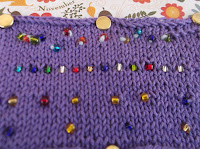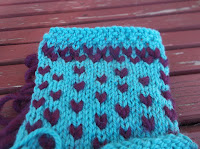
Knit beginner 1 -- This will teach the beginner basics of cast on, knit, and bind off. We touch on gauge and learning to read patterns.
Knit beginner 2 -- This class will teach the beginner basics of purling. A review of the cast on, knit and bind off will be worked on before we start new information. We again look at gauge and how purling affects it. We go further into pattern reading for beginners.
Knit beginner 3 -- This class shows how to put together knits and purls to create patterns such as ribbing and seed stitch and the characteristics each bring to our knitting. We also will learn one basic decrease and one basic increase. Again gauge and pattern reading will be delved into.
 Knit -- Cables 1 -- This class shows how to make cables, how to put cables into your project, and what their characteristics are, Pattern reading and gauge will be looked at to further develop those skills. This is to learn basic cables.
Knit -- Cables 1 -- This class shows how to make cables, how to put cables into your project, and what their characteristics are, Pattern reading and gauge will be looked at to further develop those skills. This is to learn basic cables.Knit -- Cables 2 -- This class shows how to make more advanced cables and what can be done with these. We will also look at chart reading for knitting cables. Pattern reading and gauge will not be featured as heavily in this class.
Knit -- Cables 3 -- This class will show how to make cables reversible. It's hard to believe but it can be done. We explore why this would be good to know how to do and how to apply it.
Knit -- Colorwork -- Stripes + -- This class is about striping. Adding stripes to anything is the first step to adding another color to a project, The + is learning to do chevrons. The zigzag is a classic way to add interest to the stripes They can be symmetrical or asymmetrical.

Knit -- Colorwork -- Fair Isle -- This class will show how to do this second most basic color work type, the first being stripes. We discuss common pitfalls and how to avoid them, how it is worked, how to read the chart, and how the chart plays its part in the pattern.
 |
| This sweater could be something you choose to create for the sweater class |

Knit -- Colorwork -- Mosaic Knitting -- This class will show how this technique is done, how to read the charts or the written pattern for this intriguing way of adding color.
Knit -- Entrelac -- Basic Entrelac will be taught with straight sides. We show how to put this technique to work for us. Pattern reading will feature heavily in this class as will how to measure gauge for this.
Knit -- Entrelac -- Patterning --This beyond the basic way of doing Entrelac shows how to change up the basics and what might change when you do.

Knit -- Entrelac -- Lace -- This technique takes a dainty twist in this class. We learn how to add lace to the technique.
Knit -- Entrelac -- Colorwork -- This technique will take this colorwork technique to the next level with even more color.

 Knit -- Entrelac -- In the Round - This technique shows you how to work entrelac to form a circle. Great for circular shawls and baby blankets or a beret.
Knit -- Entrelac -- In the Round - This technique shows you how to work entrelac to form a circle. Great for circular shawls and baby blankets or a beret.Knit -- Entrelac -- In the Round + -- which teaches how to make a seamless tube of your Entrelac.
Knit -- Lace -- A basic lace class will teach a variety of increases and decreases and why the basics need to be added to. Pattern reading, lifelines, gauge and blocking will be featured here.
 |
| Basic I cord |
 |
| I cord cast on, selvedge, bind off and applied I cord. |
Knit -- Socks -- Toe Up -- This class will teach a basic sock from the toe up and feature a short row heel. It is a 2 part class with a break in the middle. There is a trainer sock to learn the parts of the sock as we knit them. We teach how to read the pattern and why gauge is important to this.
 |
| Top down Toe Up |
Knit -- Socks Top Down -- This class will teach a basic sock from the cuff down. There will be a heel flap and gusset. This is a 2 part class with a break in the middle. There is a trainer sock to learn the parts of the sock as they are knit. Pattern reading and gauge importance are worked on as well. Kitchener Stitch will be taught to finish off the toe.
Knit -- Sweaters -- This class will feature a basic cardigan or a basic pullover. It will be done in 3 parts and have homework. Class 1 will be starting the back and front(s) and reading the pattern so everyone understands what needs to be done to complete these pieces. Gauge and its importance are discussed. Class 2 will be the sleeves starting and answering problems encountered. Class 3 will feature seaming and finishing techniques and address problems encountered. With concentrated effort a finished garment can be had by the end of this class.
Knit -- Mistake Corrections -- You know how to knit. But every so often things go a little sideways and a mistake happens. Depending on how you react to mistakes, you have done a lot of ripping out or your things look less than you would like them to despite most not being able to see them. We will start with basics and as things develop, address mistakes students have made and how to fix them. There is more than one way to do most things and ripping is not always necessary.
Knit -- Mitered Knitting -- Also known as Domino Knitting, this modular technique can be used in a variety of ways. Ways to measure gauge and how to read the pattern as well as ways to spice it up are discussed.
 |
| Single Miter |
 |
| Double Miter |
 |
| Lacy Miter |
 Knit -- Mobius Knitting -- Learn how to cast on in this intriguing manner with an extra long circular needle and how to choose stitch patterns to give expected and desirable results.
Knit -- Mobius Knitting -- Learn how to cast on in this intriguing manner with an extra long circular needle and how to choose stitch patterns to give expected and desirable results.
Knit -- Charted Knitting -- Learn to read charts for basic and not so basic stitches. This opens up the whole world without having to learn new languages
.
 Knit -- Double Knitting -- Basics will start with a single color. We explore how to add different stitches or colorwork to one side but not the other. Lace not appropriate for this technique.
Knit -- Double Knitting -- Basics will start with a single color. We explore how to add different stitches or colorwork to one side but not the other. Lace not appropriate for this technique.Knit -- Arm Knitting -- Learn to do this quick and fun technique using nothing more than yarn and your arms. This class will be run by demand.
Knit -- Short Rows -- Learn this useful technique that can be used for shaping or creating circles.
 Knit -- Illusion Knitting -- Learn to create a striped fabric that has a secondary surprise to it.
Knit -- Illusion Knitting -- Learn to create a striped fabric that has a secondary surprise to it.
Knit -- Smocking -- Learn how to create beautiful smocked knits for delicate baby items or something more grown up.
Knit -- Mittens and Gloves -- Learn the basics to making these winter staples. Training mitten and glove will be utilized in this special 3 hour class.
 Knit -- Beaded Knitting -- This class teaches a variety of ways to add bling to your knits.
Knit -- Beaded Knitting -- This class teaches a variety of ways to add bling to your knits. 
 Knit -- Thrums -- This technique will teach what thrums are, how to make them, how to utilize them and what garments would benefit from them and which ones won't.
Knit -- Thrums -- This technique will teach what thrums are, how to make them, how to utilize them and what garments would benefit from them and which ones won't.





No comments:
Post a Comment